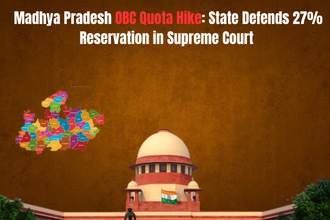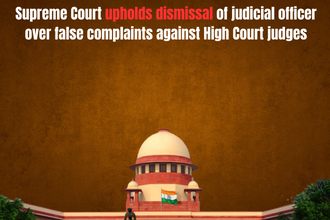The Madhya Pradesh government has strongly defended its decision to increase reservation for Other Backward Classes (OBCs) from 14% to 27%. In an affidavit filed before the Supreme Court, the State argued that backward communities collectively constitute over 87% of the state’s population yet continue to suffer from systemic exclusion, underrepresentation, and entrenched social, educational, and economic disadvantages.
The matter, titled Shivam Gautam v. State of MP and Others (T.C (Civil) No. 7/2025), is scheduled to be heard by a Supreme Court bench comprising Justice PS Narasimha and Justice AS Chandurkar on October 8, 2025.
The Demographic and Social Context
The affidavit relied heavily on the 2011 Census and subsequent reports, including a 2022 OBC Commission Report, which highlight the following figures:
- Scheduled Castes (SCs): 15.6%
- Scheduled Tribes (STs): 21.1%
- Other Backward Classes (OBCs): Over 51%
Collectively, disadvantaged communities—SCs, STs, and OBCs—account for more than 87% of Madhya Pradesh’s population. Despite this overwhelming demographic presence, OBCs were historically restricted to only 14% reservation, which the State described as “wholly disproportionate.”
The government emphasized that this underrepresentation continues in higher services, public employment, and educational institutions, thus necessitating enhanced protective measures.
Legal Challenge to the 2019 Amendment
The OBC quota hike stems from the Madhya Pradesh Lok Seva (Reservation for Scheduled Castes, Scheduled Tribes, and Other Backward Classes) Act, 1994, as amended by the 2019 Amendment Act, which raised the OBC quota from 14% to 27%. Several petitions challenged this amendment, arguing that it breached the 50% reservation ceiling laid down in the landmark Indra Sawhney v. Union of India (1992) judgment.
In 2022, the Madhya Pradesh High Court passed an interim order restraining the State from implementing OBC reservation beyond 14% and stayed the 2019 Rules. These petitions were later transferred to the Supreme Court in 2024. The apex court did not vacate the High Court’s interim order, and the matter has now been posted for final hearing.
The 50% Ceiling and Indra Sawhney Exception
One of the central issues in the case is whether Madhya Pradesh can exceed the 50% reservation cap. Currently, the State’s reservation structure is as follows:
- SCs: 16%
- STs: 20%
- OBCs: 27% (disputed)
- EWS: 10%
This totals 73%, well above the 50% benchmark. However, the State contends that the Indra Sawhney judgment allows exceeding this limit in extraordinary circumstances, such as overwhelming backwardness or regional imbalances. The affidavit argued that Madhya Pradesh squarely fits this exception given that backward classes form the overwhelming majority of the population but remain severely underrepresented.
Evidence of Persistent Backwardness
The State presented multiple reports and commissions to establish the continued backwardness of OBCs:
- Mahajan Commission (1980): Recommended a 35% reservation for OBCs in state services and educational admissions after an extensive survey.
- Madhya Pradesh Backward Classes Commission (1996–2001): Repeatedly urged for OBC reservation to be raised between 27% and 35%.
- Socio-Economic Study (2023) by Dr. B.R. Ambedkar Social Sciences University: Found persistent caste-based segregation, poor educational outcomes, economic vulnerability, and limited political representation among OBCs.
- OBC Commission Report (2022): Confirmed that OBCs constitute more than half of the State’s population and remain significantly disadvantaged.
The affidavit highlighted that OBCs face systemic exclusion such as caste-based discrimination, food-based ostracism, denial of access to public spaces, lack of presence in medium or large-scale enterprises, and poor representation in higher government services.
Economic and Social Barriers
The State argued that OBC communities continue to suffer disproportionately from economic exploitation, debt bondage, and declining traditional occupations due to industrialization. They have little to no presence in medium or large-scale business enterprises, which prevents upward mobility and entrenches structural inequality.
Such conditions, the affidavit said, justify affirmative action beyond conventional limits. The State argued that the enhanced quota is not merely a political move but a “constitutionally mandated corrective step” to remedy systemic injustice.
Administrative Paralysis Due to Court Orders
The government also drew attention to the administrative difficulties caused by interim judicial orders. Since 2022, several recruitment processes have been stalled due to the stay on enhanced OBC reservations. As a result:
- Over 4,700 posts in the Public Service Commission and the Employee Selection Board remain vacant.
- Multiple departments are facing manpower shortages.
- The State claims it is suffering “irreparable injury” from this stalemate.
The affidavit urged the Supreme Court to allow appointments under the enhanced quota, subject to the final outcome of the case, to prevent governance paralysis.
Constitutional Arguments in Support of the Hike
The State has leaned on constitutional provisions to defend the increase:
- Article 14 (Equality before Law): Permits reasonable classification to achieve substantive equality.
- Article 15(4) & 15(5): Allow special provisions for socially and educationally backward classes.
- Article 16(4): Enables reservation in public employment for backward classes underrepresented in State services.
- Article 46 (Directive Principle): Directs the State to promote the educational and economic interests of weaker sections.
According to the State, failing to enhance OBC reservation would perpetuate inequality, contravening these constitutional mandates.
What Lies Ahead
The Supreme Court’s upcoming decision will have significant implications for reservation jurisprudence in India. If the Court upholds Madhya Pradesh’s stance, it may pave the way for other States with high OBC populations to seek similar relaxations from the 50% ceiling. On the other hand, if the Court strikes it down, it will reaffirm the sanctity of the Indra Sawhney ceiling, except in narrowly defined cases.
The case is also a test of balancing social justice with constitutional constraints on affirmative action.
Conclusion
The Madhya Pradesh government’s affidavit paints a picture of entrenched disadvantage and systemic exclusion faced by OBCs despite forming the majority of the population. By increasing the OBC reservation from 14% to 27%, the State argues it is fulfilling its constitutional duty to ensure equality and social justice.
However, the legal challenge raises a critical constitutional question: Can States exceed the 50% ceiling on reservations in the name of social justice, and if so, under what circumstances?
As the Supreme Court prepares to hear this matter in October 2025, its decision will shape the future of reservation policies in India and potentially redefine the scope of affirmative action under the Indian Constitution.
Also Read
Improper For HC Judge To Not Refer Bail Plea To Earlier Judge Citing Roster Change: Supreme Court



